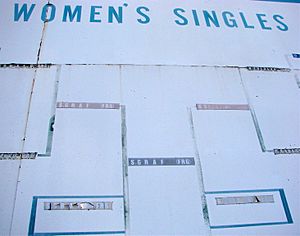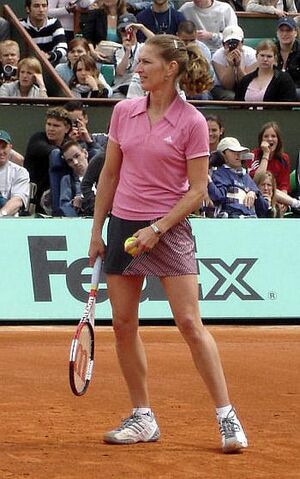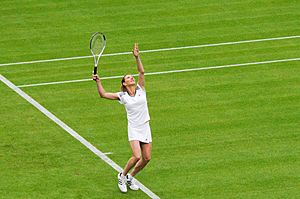Steffi Graf facts for kids

Graf in 2010
|
|||||||||||||||||
| Full name | Stefanie Maria Graf | ||||||||||||||||
|---|---|---|---|---|---|---|---|---|---|---|---|---|---|---|---|---|---|
| Country (sports) | |||||||||||||||||
| Residence | Las Vegas, Nevada, U.S. | ||||||||||||||||
| Born | 14 June 1969 Mannheim, West Germany |
||||||||||||||||
| Height | 1.75 m (5 ft 9 in) | ||||||||||||||||
| Turned pro | 1982 | ||||||||||||||||
| Retired | 1999 | ||||||||||||||||
| Plays | Right-handed (one-handed backhand) | ||||||||||||||||
| Coach | Peter Graf Pavel Složil (1986–1991) Heinz Günthardt (1992–1999) |
||||||||||||||||
| Prize money | $21,895,277
|
||||||||||||||||
| Int. Tennis HoF | 2004 (member page) | ||||||||||||||||
| Singles | |||||||||||||||||
| Career record | 900–115 (88.67%) (88.7%) | ||||||||||||||||
| Career titles | 107 (3rd all-time) | ||||||||||||||||
| Highest ranking | No. 1 (17 August 1987) | ||||||||||||||||
| Grand Slam singles results | |||||||||||||||||
| Australian Open | W (1988, 1989, 1990, 1994) | ||||||||||||||||
| French Open | W (1987, 1988, 1993, 1995, 1996, 1999) | ||||||||||||||||
| Wimbledon | W (1988, 1989, 1991, 1992, 1993, 1995, 1996) | ||||||||||||||||
| US Open | W (1988, 1989, 1993, 1995, 1996) | ||||||||||||||||
| Other tournaments | |||||||||||||||||
| Tour Finals | W (1987, 1989, 1993, 1995, 1996) | ||||||||||||||||
| Olympic Games | W (1988) | ||||||||||||||||
| Doubles | |||||||||||||||||
| Career record | 173–72 (70.61%) (70.6%) | ||||||||||||||||
| Career titles | 11 | ||||||||||||||||
| Highest ranking | No. 3 (3 March 1987) | ||||||||||||||||
| Grand Slam doubles results | |||||||||||||||||
| Australian Open | SF (1988, 1989) | ||||||||||||||||
| French Open | F (1986, 1987, 1989) | ||||||||||||||||
| Wimbledon | W (1988) | ||||||||||||||||
| US Open | SF (1986, 1987, 1988, 1989) | ||||||||||||||||
| Other doubles tournaments | |||||||||||||||||
| Tour Finals | SF (1986, 1987, 1988) | ||||||||||||||||
| Olympic Games | SF (1988) | ||||||||||||||||
| Mixed doubles | |||||||||||||||||
| Career record | 9–7 (56.25%) | ||||||||||||||||
| Grand Slam mixed doubles results | |||||||||||||||||
| Australian Open | 2R (1991) | ||||||||||||||||
| French Open | 2R (1994) | ||||||||||||||||
| Wimbledon | SF (1999) | ||||||||||||||||
| US Open | 1R (1984) | ||||||||||||||||
| Team competitions | |||||||||||||||||
| Fed Cup | W (1987, 1992) | ||||||||||||||||
| Hopman Cup | W (1993) | ||||||||||||||||
|
Medal record
|
|||||||||||||||||
Stefanie Maria Graf (born June 14, 1969), known as Steffi Graf, is a famous German former professional tennis player. Many people consider her one of the greatest tennis players of all time. She was the world No. 1 in women's singles for a record 377 weeks. This is the longest time any tennis player, male or female, has held the top spot. She also finished as the year-end No. 1 a record eight times.
Graf won 107 singles titles on the WTA Tour. This includes 22 major singles titles, which are also known as Grand Slams. She is the only tennis player, male or female, to have won each major singles tournament at least four times. This amazing achievement is called a quadruple career Grand Slam.
Steffi Graf started playing professionally at a young age. She won her first major title at the 1987 French Open. In 1988, she made history by achieving the Golden Slam. This means she won all four major titles and the Olympic gold medal in the same year. She continued to be a top player for many years, even with injuries and new rivals. In 1999, she won her 22nd and final major title at the French Open. She retired from tennis later that year at age 30.
Experts like Billie Jean King have called Steffi Graf the greatest women's tennis player ever. Her powerful forehand and quick footwork changed how tennis is played today. She was inducted into the Tennis Hall of Fame in 2004. Steffi Graf is married to fellow tennis legend Andre Agassi, and they have two children.
Contents
- Early Life and Tennis Beginnings
- A Rising Star: Early Career
- Becoming World No. 1: 1987
- The Golden Slam Year: 1988
- New Challenges and Continued Success
- Return to Dominance: 1993-1996
- Final Years on Tour: 1997–1999
- Doubles Career
- Life After Tennis
- Summary of Achievements
- Playing Style
- Equipment and Endorsements
- Personal Life
- Legacy in Tennis
- Awards and Honours
- See also
- Pickleball
- Images for kids
Early Life and Tennis Beginnings
Stefanie Graf was born on June 14, 1969, in Mannheim, West Germany. Her parents were Heidi Schalk and Peter Graf. When she was nine, her family moved to Brühl. She has a younger brother named Michael.
Her father, who wanted to be a tennis coach, first taught her how to play. He showed his three-year-old daughter how to swing a racket in their living room. She started practicing on a real court at age four. By age five, she played in her first tournament. She quickly became a top player in junior tournaments. In 1982, she won the European Championships for both 12-year-olds and 18-year-olds.
A Rising Star: Early Career
Graf played her first professional tournament in October 1982 in Filderstadt, Germany. She was only 13 years old. She lost her first match to Tracy Austin, a former world No. 1 player.
In 1983, her first full year as a pro, Graf was ranked No. 124 in the world. She didn't win any titles for three years. However, her ranking steadily improved. By 1985, she was ranked No. 6 in the world. In 1984, at age 15, she gained attention at Wimbledon. She nearly beat the tenth-seeded player, Jo Durie. She also won a tennis event at the 1984 Olympic Games in Los Angeles. No medals were given because it was not an official Olympic sport that year.
Her father, Peter Graf, carefully managed her schedule. He limited her play to prevent her from getting tired too quickly. This focus helped her improve her game steadily.
In 1985 and early 1986, Graf became a strong challenger to the top players, Martina Navratilova and Chris Evert. She often reached tournament finals or semifinals. On April 13, 1986, Graf won her first WTA tournament. She beat Chris Evert in the final. She then won three more tournaments in a row. This included beating Martina Navratilova in the final in Berlin.
Becoming World No. 1: 1987
Graf had a huge breakthrough in 1987. She won six tournaments before the French Open. A highlight was in Miami, where she beat Martina Navratilova and Chris Evert. In the French Open final, Graf defeated the world No. 1, Martina Navratilova.
She lost to Navratilova in the Wimbledon final, her first loss of the year. However, on August 17, 1987, Steffi Graf became the world No. 1 player for the first time. She held this top spot for an amazing 186 weeks in a row. This was a new record in women's tennis.
The Golden Slam Year: 1988
Steffi Graf started 1988 by winning the Australian Open. She beat Chris Evert in the final without losing a single set in the whole tournament.
At the French Open, Graf won her second straight title there. She defeated Natasha Zvereva 6–0, 6–0 in a very quick final. This match lasted only 34 minutes and was the most one-sided Grand Slam final ever.
Next, at Wimbledon, Martina Navratilova had won six titles in a row. Graf was behind in the final but came back to win. She then won the US Open, beating Gabriela Sabatini in the final. This win meant she had achieved the Grand Slam. She won all four major titles in one calendar year. Only two other women had done this before. Graf's 1988 Grand Slam was special because it was won on three different court surfaces (grass, clay, and hard court).
To top off her incredible year, Graf won the gold medal at the Olympic Games in Seoul. This made her the first tennis player ever to achieve the "Golden Slam." She won all four Grand Slam titles and the Olympic gold medal in the same year. She also won her only Grand Slam doubles title at Wimbledon that year, playing with Gabriela Sabatini.
New Challenges and Continued Success
1989: Another Strong Year
Many people wondered if Graf could win another Grand Slam in 1989. She started the year by winning the Australian Open. This extended her Grand Slam winning streak to five events.
Her Grand Slam winning streak ended at the French Open. There, 17-year-old Arantxa Sánchez Vicario beat her in a tough three-set match. Graf then recovered to defeat Martina Navratilova in the Wimbledon final. She also won the US Open for her third Grand Slam title of the year. Graf ended 1989 with an amazing 86 wins and only 2 losses.
1990: Facing New Rivals
Graf won the Australian Open again in 1990. This was her eighth Grand Slam singles title. Her winning streak reached 66 matches before she lost to Monica Seles in Berlin.
Graf lost to Monica Seles again in the French Open final. At Wimbledon, she lost in the semifinals to Zina Garrison. This ended Graf's streak of reaching 13 Grand Slam finals in a row. She also lost the US Open final to Gabriela Sabatini. Despite these losses, Graf still finished 1990 as the world's top-ranked player.
1991-1992: Injuries and Changes
The years 1991 and 1992 were challenging for Graf. She faced injuries and Monica Seles became the new dominant player. Seles took the world No. 1 ranking from Graf in March 1991, ending Graf's record 186-week hold.
Graf won her third Wimbledon title in 1991, beating Gabriela Sabatini in a very close match. In 1992, she missed the Australian Open due to illness. She also changed coaches, working with Heinz Günthardt for the rest of her career. Graf reached the French Open final but lost to Monica Seles. However, she beat Seles in the Wimbledon final that year. At the 1992 Barcelona Olympics, Graf won a silver medal.
Return to Dominance: 1993-1996
1993: Back to the Top
In 1993, Monica Seles was injured in an incident during a match. This meant Seles was unable to play for more than two years. During this time, Graf returned to her dominant form. She won 65 out of 67 matches. She also won three of the four Grand Slam events and the year-end WTA Championships.
Graf won her first French Open title since 1988. She then won her fifth Wimbledon title. At the US Open, she won again, making it three Grand Slam titles for the year. She finished 1993 by winning the WTA Championships.
1994: Continued Success
Graf started 1994 strong, winning the Australian Open easily. She then won her next four tournaments. Her winning streak of 36 matches ended in Hamburg. She lost in the semifinals of the French Open and in the first round of Wimbledon. This was her first first-round Grand Slam loss in ten years. She then struggled with a back injury. Despite this, she reached the US Open final but lost to Arantxa Sánchez Vicario.
1995: More Grand Slam Wins
Graf missed the Australian Open due to injury. She returned to win four tournaments in a row. She then beat Arantxa Sánchez Vicario in the finals of both the French Open and Wimbledon. The 1995 Wimbledon final was a very exciting match.
In August, Monica Seles returned to tennis. The US Open was Seles's first Grand Slam since her injury. Graf and Seles met in the final, and Graf won in three sets. Graf finished the year by winning the WTA Championships.
1996: Triple Grand Slam Defense
Graf again missed the Australian Open due to foot surgery. She returned to win titles in Indian Wells and Miami. She then successfully defended the three Grand Slam titles she won the year before. She beat Arantxa Sánchez Vicario in a very long and close French Open final. She also beat Sánchez Vicario in the Wimbledon final.
Graf then defended her title at the US Open, defeating Monica Seles in the final. She also won her fifth and final WTA Tour Championships title. In 1996, Graf became only the second player to win a Grand Slam on hardcourt, clay, and grass in the same season. She had also done this in 1993 and 1995.
Final Years on Tour: 1997–1999
The last few years of Graf's career were affected by injuries, especially to her knees and back. She lost her world No. 1 ranking to Martina Hingis in 1997. That year, she lost early at the Australian Open and French Open. She had knee surgery and missed Wimbledon and the US Open.
In 1998, Graf played fewer tournaments due to injuries. She had wrist surgery. However, she still managed to win the Philadelphia title, beating world No. 2 Hingis and world No. 1 Lindsay Davenport.
At the start of 1999, Graf reached the semifinals in Sydney. She beat Serena Williams and Venus Williams there. She then reached the quarterfinals of the Australian Open.
At the French Open, Graf reached her first Grand Slam final in three years. She made a memorable comeback to defeat the top-ranked Martina Hingis in three sets. Graf became the first player in the Open Era to beat the first, second, and third ranked players in the same Grand Slam tournament. After this win, Graf hinted that it might be her last French Open.
Graf then reached her ninth Wimbledon singles final, but lost to Lindsay Davenport. On August 13, 1999, at age 30, Steffi Graf announced her retirement from professional tennis. She was ranked No. 3 at the time. She said she had achieved everything she wanted in tennis and was no longer having fun.
Doubles Career
Steffi Graf also played doubles matches throughout her career, winning 11 doubles titles. From 1986 to 1990, she often partnered with Gabriela Sabatini. They won the 1988 Wimbledon Championships together. They also reached the French Open finals three times.
Graf also played mixed doubles sometimes, but she never won a title. In 1999, she famously partnered with John McEnroe at Wimbledon. They reached the semifinals before Graf had to withdraw due to injury concerns for her singles final.
Life After Tennis
After retiring, Graf played in several exhibition matches. She played against former rivals like Jelena Dokic, Amanda Coetzer, and Arantxa Sánchez Vicario. In 2004, she played Gabriela Sabatini in Berlin to raise money for her charity. The tennis stadium in Berlin was even renamed the "Steffi Graf Stadion" in her honor.
In 2009, Graf played an exhibition match at Wimbledon's Centre Court. She played against Kim Clijsters and also played mixed doubles with her husband, Andre Agassi.
Summary of Achievements
Steffi Graf won seven singles titles at Wimbledon, six at the French Open, five at the US Open, and four at the Australian Open. Her overall record in Grand Slam events was 278 wins and 32 losses (90 percent winning rate). Her career prize money totaled over $21 million. She was ranked world No. 1 for a record total of 377 weeks. This included 186 consecutive weeks at the top.
Playing Style
Graf's main strengths were her powerful forehand and amazing footwork. Her forehand was so strong and accurate that people called her Fräulein Forehand. She could hit the ball with great speed and precision.
She also had a strong backhand, but she often used a backhand slice. This slice shot was very effective. It allowed her to set up her powerful forehand. Graf's serve was also very fast, reaching up to 183 km/h (114 mph). She was also good at hitting volleys at the net.
Steffi Graf was a very versatile player. She could play well on all court surfaces. She is the only player, male or female, to have won the calendar-year Grand Slam on three different surfaces. She is also the only player to have won each Grand Slam at least four times. Her athletic style and aggressive play from the back of the court helped shape the modern game of tennis.
Equipment and Endorsements
Early in her career, Graf used Dunlop tennis gear. In 1985, she signed a deal with Adidas for her clothing and shoes. She used Dunlop racquets for many years before switching to Wilson in 1994. Her racquets were strung very tightly, which helped her hit with such power.
Graf also had many endorsement deals with companies like Opel, Rexona, Barilla, and Citibank. She appeared in commercials with her husband, Andre Agassi, for companies like Canon Inc. and Longines. In 2015, she became an ambassador for Kerala tourism.
Personal Life
During her career, Graf lived in her hometown of Brühl, Germany, and also in Florida and New York City. From 1992 to 1999, she dated racing driver Michael Bartels.
She started dating fellow tennis player Andre Agassi after the 1999 French Open. They got married on October 22, 2001. They have two children: a son born in 2001 and a daughter born in 2003. The Graf-Agassi family lives in Summerlin, near Las Vegas. Agassi has said they are not pushing their children to become tennis players.
In 1991, the Steffi Graf Youth Tennis Center in Leipzig was named after her. She also started a charity called "Children for Tomorrow" in 1998. This foundation helps children who have been through war or other difficult situations.
Legacy in Tennis
In December 1999, a group of experts named Steffi Graf the greatest female tennis player of the 20th century. She holds the record for the most weeks as world No. 1 (377 weeks). She also won 22 major singles titles. Her powerful and athletic playing style helped create the modern game of tennis.
Many tennis legends and experts agree on her greatness. Billie Jean King called her "definitely the greatest women's tennis player of all time." In 2012, Tennis Channel named her the greatest female tennis player ever. In 2016, Serena Williams named Graf as one of the greatest players of all time.
Steffi Graf, along with Boris Becker, helped make tennis very popular in Germany. Tennis writer Steve Flink called Graf the best female player of the 20th century.
Awards and Honours
Graf received many awards during and after her career. She was named the ITF World Champion seven times. She was also voted the WTA Player of the Year a record eight times. She was named the German Sportsperson of the Year five times. For her Golden Slam in 1988, she received the BBC Overseas Sports Personality of the Year.
In 2004, the Berliner Tennis-Arena was renamed Steffi-Graf-Stadion in her honor. Graf was inducted into the International Tennis Hall of Fame in 2004. She was also inducted into the German Sports Hall of Fame in 2008. In 2015, she received the Jean Borotra Sportsmanship Award. In 2022, she was honored with the Great Immigrants Award.
See also
 In Spanish: Steffi Graf para niños
In Spanish: Steffi Graf para niños
- Graf–Navratilova rivalry
- Graf–Sabatini rivalry
- Graf–Seles rivalry
- List of female tennis players
- List of tennis rivalries
Pickleball
Steffi Graf and her husband, Andre Agassi, have both started playing Pickleball. They play as doubles partners and in singles matches.
Images for kids







